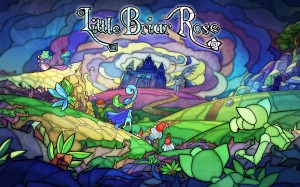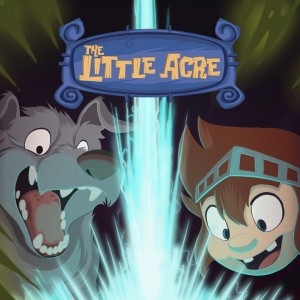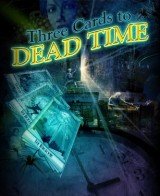Review for Little Briar Rose

Once upon a time, a reviewer sat down to play a pretty little game about a sleeping princess and a whole lotta princes... Little Briar Rose, by Elf Games, is a small though gorgeously designed foray into the world of Sleeping Beauty. There are a few deviations from the source material (I’m pretty sure there were no spriggens, gnomes, or mermen in the original) to support some entertaining puzzles and funny characters, but there’s really not that much innovation around the main elements of the same old story – you’re still just a prince looking to wake up your true love.
Originally conceived as a freeware adventure that launched in 2015 before being significantly upgraded for commercial release, the game opens with the traditional fairy tale: a beautiful princess surrounded by three good fairies. Unfortunately, the trio anger an evil fairy who whispers promises of death. Fairy tales being what they are, the golden-locked lady is of course saved by the good fairies and merely falls into a deep sleep, but is unable to awaken on her own. This prologue unfurls via panels looking like animated stained glass playing out on a larger, impressive window.
Once the introduction is over, the story proper begins, in which you, Prince Stephen, must explore this stunning world in order to save your princess. Though you’re stuck in the middle of the woods, seemingly with no direction, there is a helpful fairy nearby who is willing to assist you. She remains in the area where you begin your adventure, and if you go back to meet her, you can save your game and also tap (I played the game on my iPad) on her to get hints. You don’t need to travel there for help, however, as a small button on the game screen also accesses the hints wherever you may be, though there is a small cooldown period after each use. Either way, to actually get those hints you’ll need to solve a very simple jigsaw puzzle. In fact, it’s so simple it seemed to be the same one each time I tried. The hints you do get are not super-involved, typically telling you whether there is still an action to be performed within that particular screen.
Moving around is easy: simply tap on the screen where you want your prince to move. The interface is also fairly uncomplicated, with an image of a bag that opens up your inventory. You don’t pick up a lot of items, so the inventory is a straightforward wheel, with empty slots that fill in with items you gather. Though it may be different on the PC, on iPad it can be hit-or-miss trying to tell what might be a hotspot. Thought bubbles appear above characters you can talk to, and small green arrows pop up as you get close to exits. Exclamation points sometimes show up over items that can be picked up or trigger a puzzle, but they often appear only if you get close to or actually tap on the item needed first, and there are only very subtle indications that there is something you may want to move closer to (for example, a color that seemed to stand out drew me to an item that could have been easily missed). Even then, if the object isn’t immediately needed, you’ll just get the exclamation point and a small observation from the prince, but no actual interaction you can accomplish just yet.
Of course, your adventure is not as straightforward as the interface, as the way to the princess’s castle is blocked off by a wall of thorns. To make your way to her, you’ll need to explore the area around the castle, helping all manner of creatures in order to get to where you’re going. Unfortunately for the prince, each species is in the middle of some debate or predicament, and they won’t help you until you help them first. Pay attention to what the little gnomes or stalwart merpeople tell you – their favorite colors or taste in architecture may help you solve their quandaries. Those gnomes, though, won’t give you a hand unless you help them construct a building that’s likeable but not flashy (and a whole list of other characteristics), in the words of one of the little blokes. Each of these puzzles you must solve for the sundry groups either involves gathering inventory items or playing through minigames where you select from a variety of options to come up with the correct creation.
Don’t get too attached to the prince, however. If you get one of the main puzzles wrong, such as crafting the incorrect type of house, for example, you don’t get any second chance. Poof, the prince is gone, which was quite surprising to me the first time it happened. But not to worry. In steps another prince to pick up where the previous one left off. I went through about four princes before I made it to the end of the game. So much for finding your one true love. If you’re a decent puzzle solver, maybe you can take Prince Stephen right through to the end (sadly, my problem-solving skills leave a lot to be desired). The prince replacement isn’t hugely disruptive or disappointing, however. Aside from a change in outfit and look, there really is no difference between them, as they are just the vehicle for learning about the different characters living around the castle.
There’s more to the story than stiff, resolute princes searching earnestly for a fair maiden, with some nice bits of humor throughout the tale. I personally loved the gnomes, like the big-bearded architect who gets so angry when something doesn’t go his way that he throws his papers around in a funk. In another instance, you must persuade some ornery mermen to help you. Some of that persuasion involves fishy disguise work – seeing the winsome gnomes trying to keep their dignity when their “clothes” keep slipping down is hilarious.
Little animations further liven up the world, like a small gnome sitting and swinging his tiny legs as puffs of smoke rise from his pipe. Such artistic details show care in the design, like the fact that the architect gnome carries around a little ruler and has a house on his pointed cap, while the artist has a paintbrush with a splash of ink on his. These personal touches even make their way to the speech bubbles (like a green leaf appearing in the corner of the prince’s, or a crown and pipe for the leader of the gnomes), helping you to keep track of who’s talking at any time.
The game is gorgeous overall, and I could easily have spent my time just enjoying the stained glass aesthetic of each scene, from the mushroom-strewn gnome abode to a tranquil pond surrounded by merpeople to a grey, rocky cave overrun with green spriggens. The use of color is equally pleasing: one area with verdant grass almost ripples with light and dark shades of green, all set in the center of thorns that range from mauve to lavender to deep purple.
Matching the bright beauty is jaunty, though slightly off-kilter, music. I found the game’s sound, without any voice acting apart from a narration at the beginning of the game, to be soothing, from the tinkling of chimes to the little pops when thought bubbles are clicked off as you talk to the various characters. One particularly nice bit of sound work is the noise of breaking glass as bunches of thorns disappear when you progress.
The game isn’t all just enjoying the sights and sounds, however. Though there really aren’t very many locations in total, every area you visit has its own overarching objective to complete. Each group of characters has their own space adjacent to a central hub containing an imposing mushroom structure. The one main puzzle per area is self-contained for the most part, but at times you will have to visit other groups to get help. With no quick travel option, this can lead to quite a bit of backtracking. When you complete any group’s task, you’ll receive a key to the central mushroom structure that opens up a labyrinth to navigate. The maze involves moving multiple circular plates so that a small wisp of fire can travel from the outside to the center. The deeper into the game you get, the more difficult the labyrinth becomes to solve. There is no skip button for this puzzle (or any of the others – this game feels casual but not that casual), so you will need to work through several of them before you can finish your quest.
There are also a few minigames sprinkled throughout, like a small fishing game where you must tap the screen to catch a fish without tiring by expending too much energy. You’ll eventually find a rhythm to the tapping, though this is not too difficult. One annoying thing about the puzzle is that you must complete it a number of times in order to proceed, which becomes a bit tedious. One fun minigame involves sorting through various ideas the fairies are having, sorting negative from positive thoughts. It’s timed in that the ideas, represented as icons appearing in thought bubbles, don’t stay on the screen long. However, once I figured out the pattern, I found the timing to be just the right amount of challenge.
Depending on how well you fare, you may spend about 2½ to 3 hours on your journey to kiss the beloved princess. (Possibly with many different princes along the way; not really my idea of romance.) While there is no such option for the iOS version of the game, on Steam there’s an interesting sounding Mighty Princess mod that allows you to play the game with as many as seven different princesses instead of princes. This seems like a welcome bit of innovation for a game that, although pretty and entertaining, doesn’t bring anything wildly new. It’s still the same fairy tale of a damsel in distress being saved by a fair prince that has been told in various forms for hundreds of years. Still, if you’re looking for a respite from the rigors of everyday life, Little Briar Rose is a beauty you’ll have a charming time exploring.



























